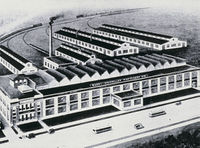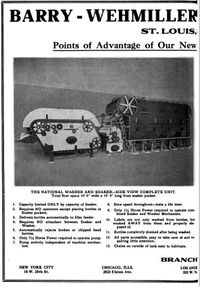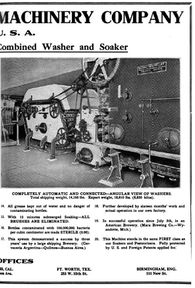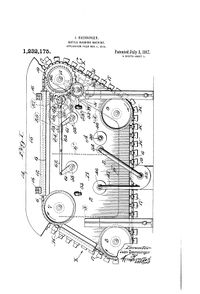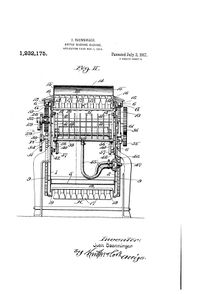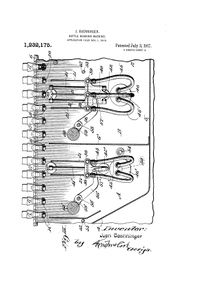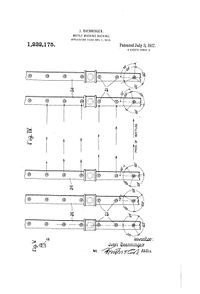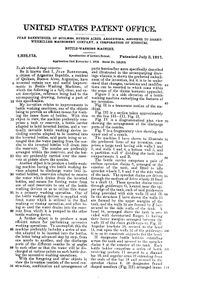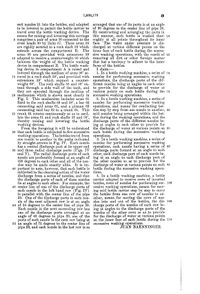Informationen zu Barry Wehmiller: Unterschied zwischen den Versionen
Rb (Diskussion | Beiträge) |
Rb (Diskussion | Beiträge) |
||
| Zeile 48: | Zeile 48: | ||
'''1950'''<br> | '''1950'''<br> | ||
A departure from the Super-National and its cleaning brushes, the International all-hydro bottle cleaner is introduced, with an impressive recommended operating speed of 500 bottles/minute. <br> | A departure from the Super-National and its cleaning brushes, the International all-hydro bottle cleaner is introduced, with an impressive recommended operating speed of 500 bottles/minute. <br> | ||
| − | + | '''1951'''<br> | |
| − | + | Lillie Rassieur (formerly Wehmiller) resigns as president. Fred becomes president, and Paul is named executive vice president. | |
| + | Barry-Wehmiller Ltd. is founded in London to provide more effective service and modern machinery outside of the US, without currency restrictions.<br> | ||
| + | Barry-Wehmiller purchases the Edward Ermold Co. of New York, with its labelers and unpackers, as well as the Bruceway can markers and uncasers.<br> | ||
| + | '''1953'''<br> | ||
| + | William A. Chapman joins Barry-Wehmiller as executive assistant to Fred. Bill had been involved with the company as an Arthur Andersen accountant.<br> | ||
Version vom 15. September 2021, 10:04 Uhr
Barry-Wehmiller History
Quelle: https://www.barrywehmiller.com/story/history 2021
1885
Thomas J. Barry becomes half owner of a small millwright and general repair shop in the south part of St. Louis, Missouri (USA).
1888
Barry opens a machine shop at 21st and Walnut streets, in St. Louis, Missouri (USA), to provide conveying and transportation equipment to malt houses. At this time, St. Louis was third in the nation for beer production—Anheuser-Busch alone sold 500,000-plus barrels of beer.
1894
Alfred Wehmiller, Barry’s brother-in-law, joins the millwright business as a draftsman.
1897
The Barry-Wehmiller Machinery Company is incorporated; with Barry as president and Wehmiller as secretary.
1901
The company designs and erects its first continuous basket pasteurizer, an economical machine that totally submerged refillable bottles. A soaking machine also is developed to fill and empty bottles of various solutions.
From a Catalog: "Our soaking machines were the first ever built in which the tank was divided up into compartments or sections by transverse partitions, and in which the general direction of travel of the bottles was vertical instead of horizontal."
1903
Barry dies, and Wehmiller becomes president and treasurer.
1913
Barry-Wehmiller builds a new plant at 4660 West Florissant Avenue in St. Louis, Missouri (USA), with strategic access to railroads, moving from 21st and Walnut streets, which had housed the company since 1888.
From a Pamphlet: “The location affords unsurpassed railroad connections for the plant, which is supplied with three separate private switches for the transportation of all raw and finished products to and from the different buildings."
| |
1916
Wehmiller is recognized for his contributions to the dairy industry.
From a Press Notice: “Head of the Barry-Wehmiller concern, is one of the few St. Louisans who deserves the gratitude and praise of countless thousands of people throughout this country, for he is the inventor of the famous ‘Barry-Wehmiller Way’—equipment which is justly claimed and proved to be the ‘Last Word’ in the production of ‘Safe Milk’…. The Barry-Wehmiller wonderful equipment washes and sterilizes the bottles, fills them with clarified milk, seals them air-tight, submerging them for one hour and twenty minutes, pasteurizing the milk at 145 degrees and cooling it to 36 degrees.”ybr>
1917
Patent application granted to Wehmiller and Barry-Wehmiller for a “method of pasteurizing liquids.”
1920
Prohibition begins, and facing an 80 percent loss in US sales, Barry-Wehmiller focused on the international brewing industry and the production of dairy washers and pasteurizers, introducing the patented National pasteurizer during this time.
1927
Wehmiller dies, and his widow, Lillie, becomes president.
1933
Prohibition ends, reinvigorating the bottling machinery business and the brewing industry. In anticipation of the repeal of Prohibition, the Super-National bottle cleaner is developed.
1934
Alfred Wehmiller’s son Fred joins the company as a vice president after graduating from college the year before.
1935
Alfred is named general plant superintendent.
Patent application granted to Barry-Wehmiller for an “apparatus for pasteurizing liquids in containers.”
1939
The revolutionary BW Vortex pasteurizer is introduced, expanding Barry-Wehmiller’s reach both within and outside of the brewing industry.
1942
Alfred Wehmiller’s son Paul is named a vice president, and devotes his time to US and international sales, especially in South America.
Patent application granted to Barry-Wehmiller for a “process of pasteurizing liquids in containers.
1944
Barry-Wehmiller earns the Army-Navy “E” Award for its support of World War II production needs. The company converted its facilities to produce 20mm projectiles, shell washers, components and fixtures for bomber turrets, gun yokes and other machine tools; team members grow victory gardens on the grounds.
From a US Navy website: “Representing only 5 percent of the estimated war plants in the nation, those plants meeting the stringent eligibility requirements ranged in size from a one-man plant to large corporations and included facilities that converted from peace to war production, as well as new plants built especially for war purposes…. Excellence in quality and quantity of production were two of the determining factors in granting Awards.”
1946
Barry-Wehmiller’s research department is founded to improve bottling machinery.
1950
A departure from the Super-National and its cleaning brushes, the International all-hydro bottle cleaner is introduced, with an impressive recommended operating speed of 500 bottles/minute.
1951
Lillie Rassieur (formerly Wehmiller) resigns as president. Fred becomes president, and Paul is named executive vice president.
Barry-Wehmiller Ltd. is founded in London to provide more effective service and modern machinery outside of the US, without currency restrictions.
Barry-Wehmiller purchases the Edward Ermold Co. of New York, with its labelers and unpackers, as well as the Bruceway can markers and uncasers.
1953
William A. Chapman joins Barry-Wehmiller as executive assistant to Fred. Bill had been involved with the company as an Arthur Andersen accountant.
1917 US Patent 1 232 175
